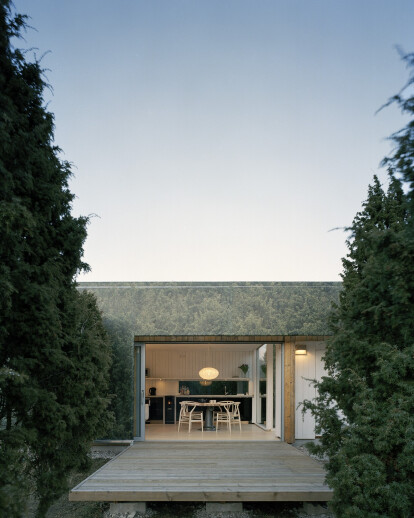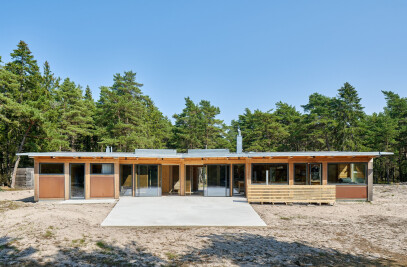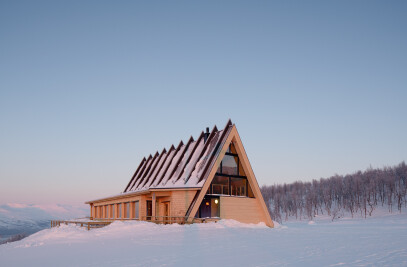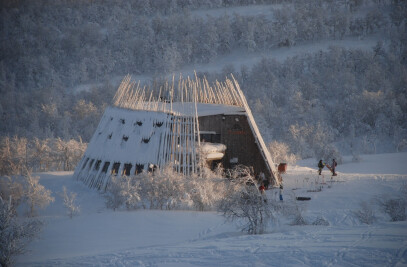The Juniper house is our own designed and built vacation house. It is situated in Gotland, a Swedish island in the Baltic sea.
This house is our summer and weekend cottage. When my wife, Ulla Alberts and I had children we decided that we should build our own vacation house close to her five siblings in Gotland. The flat plot had a lot of junipers on it. Both Ulla and I are architects and partners in Murman Arkitekter AB.
In Gotland you either build a stone house or a wooden house. We decided that we wanted to build it in wood because it should be easy to warm up.
We thought on an early stage that we wanted to do this house cheap and well functional. We wanted to try another way than the usual in Gotland to adapt a house on a plot. As 3 meters high junipers are very old and beautiful, we wanted to show them respect. We started with measuring all junipers, before we designed the house. We found a glade, where we could place the house without taking down too many junipers.
Then we started sketching.
All the members of the big family have summer cottages in the neighborhood and close contact with the family was crucial, but there was also a need for a private zone.
Towards the lawn and the other family members we have the afternoon sun terrace. The platform acts as a bridge towards the rest of the family and is also a half-private zone.
Towards east facing the morning sun for breakfast we wanted a private breakfast zone.
By car you approach Juniper House via a cul-de-sac that ends in a sheep fence towards the open moor.
There is a grove of high junipers and a couple of white plastered houses visible. Embedded in a glade 5 meters to the right lies Juniper House. The house is barely visible, like a mirror of its own surroundings. From the sea one does not see that much of the house until one is close and sees the deck and the white painted entrance, and the moor appears diagonally through the house.
It works well as a vacation house.We wanted it to be experienced as being part of the area it stands on. The house is placed so that you have junipers just a foot from the façade. The original glade was crossed by a natural path through the house to the moor. Today you feel that opening as a diagonal through the house where you feel as the nature is crossing the house that is in this part only 1.5 m wide.
A wall of glass from ceiling to floor stands towards the minimal yard. From the interior you have a strong feeling of being in the nature. Both light and the path “flow” through the house and a terrace of white local limestone separates the kitchen from the master bedroom.
Thanks to the glass partitions and the white interior walls, the small court yard is experienced as part of the inside. From the master bedroom there is a lot of sky visible, due to the glass partitions from floor to ceiling, and through the low placed window, beside the bed one can spot wild rabbits in the morning from ones bed. There is only a curtain separating the bedroom from the rest of the house which makes it feel bigger than it is.
The centrally placed kitchen works as a living room. The wide sliding doors towards the terrace and the enclosed yard make it possible to have good contact with the nature during all types of weather. The sliding glass partitions also works as a temperature regulator while minimizing draught problems.
The sofa is our own design and the central table is made of massive ash assembled on a drawing board stand. The chairs are the classic Y-chair designed by Hans Wegner in 1950.
Our ambition was to design a house adapted to the site and the nature.
We have noticed that the big glass walls to the atrium lets in a lot of sunlight which gives us a nice temperature inside. The diagonal openings ventilate the house when it is warm and are closed when it is cold. Beside we have an old stove that heat up the all-purpose room cold days. It does not consume much energy.
As we have the netvinyl on 40 cm distance from the wood façade, it is protected from wind and rain.
The sliding glass parts are clad with aluminium from Velfac and full aluminium from Schüco. The smaller glass partitions are fixed to an aluminum profile and mounted aligned with the façade panel.
The floor is ash, oiled with white pigment. The walls and ceiling are painted white and for the kitchen we have used a concrete board from a local factory (Skulpturfabriken) in Boge, Gotland. The other parts of the kitchen are from IKEA.
The walls are isolated with 120 mm mineral wool. The ground is a concrete plate. The roof is flat clad with tar paper. The wooden facade is treated with a combination of terpentine, tar and linseed oil.
In the year 2000 we worked as architects with the Scandinavian office in Stockholm for the Boston Consulting Group. The building was of highest preservation Class and we were not allowed to touch the walls so we put in meeting rooms as boxes in the bigger rooms. They had a surface that worked as sound insulation, we wrapped them in perforated netvinyl with images on, and there started the idea. On Gotland we had our wooden box among the junipers, it come natural to us to take a close up picture of the existing junipers and make a big wallpaper out of that.
We wanted the façade to be experienced as a playful comment to the Gotland authority’s ambition to not let modern architecture be visual in the landscape. It is also an experiment and investigation in what you see and do not see of a house and how this affects you and how you experience colour, texture, surface, material, transparency, inside contra outside, light on and through the façades. For us as architects it is an important experience.
It is our own family’s vacation house. Hans Murman, Ulla Alberts ,and our children Mats-Hjalmar 15 and Magnus 11, Hans has a gown up son who sleeps in the alcove beside the kitchen, when he is visiting us. Our neighbors and Ulla’s family have helped us build the house so they are part of the project, our colleagues are interested and we have visits from all over Europe during summers, the Authorities have been there on a study visit. Fascination is the most common reaction.
The slow growing junipers that surround the house are green throughout the whole year. I took a photo of the existing junipers and used that as the base for the tailor-made cloth that is 35 meters wide and 3 meters high and wrapped onto three sides of the house the netvinyl cloth is put on a galvanized steel construction at a distance of 40 centimeters from the façade. On the north and south side of the house the cloth is extended a few extra meters for privacy and to hide the outdoor shower from the neighbors.
The company that helped us wit the Big image is called Big Image Systems in Sweden. They print big pictures for advertising and for film studios.
The Y chair is from Carl Hansen, Copenhagen


































